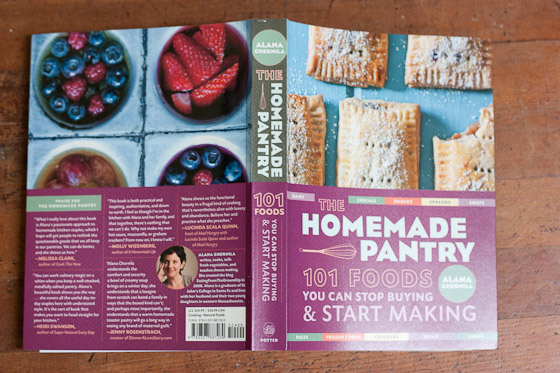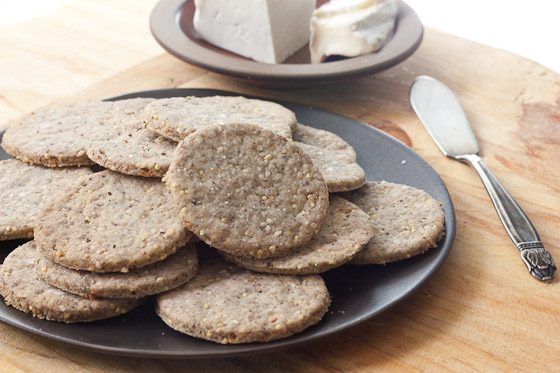In short, it's better for us and our health and also better for the planet. Of all the reasons though, I love the last one, the one that insists you'll start thinking differently about food. I think this is true anytime you step into the kitchen to prepare a recipe. You're taking the care to feed yourself and your family, to try a new recipe or technique, or simply to chop herbs and wash greens for the week's lunches. It's all about intention and setting aside a little chunk of time to prioritize the way we feed ourselves. In this sense, the book stays close to home, with stories about raising daughters, Chernila's relationship with her husband, and life on the farm. Chernila discusses how she came to certain recipes, why she likes them, and walks you through more difficult tasks and techniques. While she stays close to home, there is a hint of a broader, more global discussion:
“If we are to become people who make butter, we might have to shift the way we see ourselves a bit. We might have to get into the adventurous spirit and unearth our own curiosity about where our food comes from.”
So yes, it's fun to make ketchup at home. But beyond fun: it's important, too, because we know where exactly the tomatoes came from and what they looked like when they were picked. We were there when it was made -- heck, we made it--and it's got to taste better for it.
Now as with anything, there has to be a balance. It's not likely that most of us have the time (or energy) to make all of our own condiments, bread, pasta noodles, ice cream, butter, and yogurt. Even Chernila says that any given week looks different. Some weeks she'll have a rockstar few days of tackling lots of pantry staples and getting homemade dinners on the table. Other weeks, it'll be all she can do to make a homemade batch of granola and granola bars for the girls to eat on the ride home from school. Such is life. For all of us, I think. And I like Chernila's honesty about this; it makes the book and her approach to cooking seem much more inviting and exciting rather than overwhelming and discouraging.
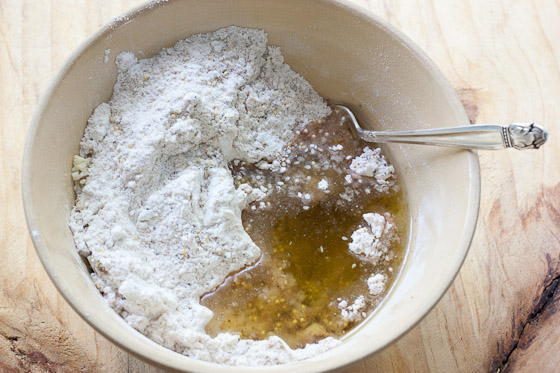
Mixing the Cracker Dough: As Easy as a Flip of a Fork (or Hand)
Flipping through the cookbook, numerous recipes stick out as things I can't wait to try. There is the homemade ricotta, Car Snacks (different nutty bars for the ride home from school), homemade ketchup & mustard, veggie burgers, hamburger buns, graham crackers, easiest chocolates, fruit roll-ups, toaster pastries, and chocolate sandwich cookies. Where to begin? The thing that strikes me about the recipes is the overall simplicity here. You’ll see a recipe for Ravioli, not Stinging Nettle and Aged Gouda Ravioli. Just ravioli. Sometimes after reading a batch of the newest food magazines, the ways in which people try to reinvent very good, basic foods to make them more marketable, new, and interesting can become tiresome. That won’t happen here. You’ll find recipes for applesauce, lasagne, and oatmeal. That’s not to say this is a boring book or that these recipes are all intuitive -- they’re not in the least. But they’re also not trying to be something they’re not.
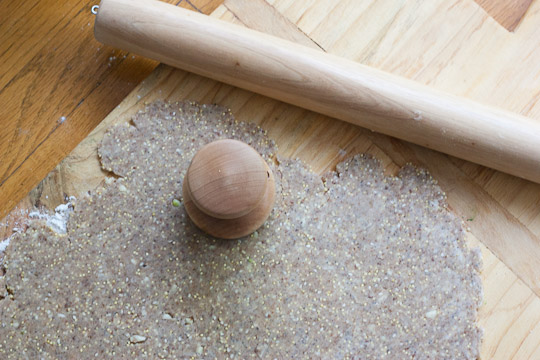
Rolling Out Crackers
One such simple, delightful recipe are the homemade crackers. Now I should preface this by saying I eat crackers often at home in the late afternoon. I have a weakness for Triscuits, but I'm really not too discerning. A good cheese cracker or rye cracker does the trick, too. So when I came across the recipe for Wheat Crackers in The Homemade Pantry, I knew I had to make them. And after making them and discovering how simple and delicious they are, I knew I had to share them with you. These crackers contain millet and flax seed. They're made with olive oil and two different kinds of flour, are super simple to roll out, and are infinitely adaptable with any kind of herbs you'd like to add, grated cheeses or ground nuts. Also: they're way, way better than a store-bought cracker and cheaper to make. While I think the homemade butter is next on my list, the crackers were a good place to start. They make the kitchen smell toasty and inviting, and yield a week's worth of 4 p.m. snacks. All good things.
Before we get to snacks and homemade crackers, I took a moment to ask Alana a few questions about the process of writing the book and coming up with the recipes. Here's what she had to say:
1. Can you describe what a typical day was like in writing the cookbook?
The book really did come straight out of our kitchen as it is on any given day. So a typical day involved all of the craziness in any other day of living and working and feeding a family, plus a whole lot of recipe testing and writing. There were days when I would start right after Joey and the girls left for school -- cooking, sitting down on the couch to write, then going back to cook. Then I'd take a break and maybe cobble together some dinner, and then I'd work deep into the night. It was great work, but all-encompassing. And my family was very, very patient. There was a fair amount of pizza (not homemade) for dinner because I would have spent the whole day trying to figure out the best way to fill a homemade twinkie. The irony did not escape me that I was so busy writing about food at home, that I didn't have time to actually make food at home! It was a huge day when that manuscript was finished.
2. What's been the biggest surprise or challenge you faced in the process of writing and promoting the book?
I found that a first book is a lot like a first child-- everything is a surprise! I think that because working on the headnotes of this particular book was a lot like writing a memoir of sorts; I was unprepared for how emotional the process of actually writing those headnotes would be...I've never been so immersed in the process of writing. The process of promoting the book has been a challenge, I think because I'm not always a natural saleswoman. But there's been this wonderful aspect to it-- I've gotten emails from people all over the country who are so excited to make their own staples at home. I love these emails! They tell me what they've made, and how their families react (always positively, so far!). It's just so great to feel like I get to hang out with so many people in their kitchens. It really does feel like an honor.
3. What are your favorite recipes in the book--the ones you make over and over again? And why?
There are several recipes in the book that are mainstays of our weekly diet. I wrote the book because I felt like it was a book I needed to have on my own shelf, and sure enough, I cook from it all the time. My favorites are granola, car snacks (each family member has their favorite), yogurt, ricotta, butter, and crackers. I also have a sweet spot in my heart for the graham cracker recipe. I had such a specific taste and crunch level in my head for that one, and I feel pretty great that I found the right combination of elements.
4. What do your girls think about seeing their faces in print?
They've been so great about all of this--mostly I think because they've had some ownership over the process. They really think of this as their book, and I agree. Jennifer May, the photographer who shot the book, became part of our family over the course of that year. The girls loved her, and they got to see the photos at every step in the process. They like to show their friends the book, and each of the girls have their favorite photos. I've tried to be really sensitive throughout the process though. Just recently Sadie (who is now nine) has put limits on how much of her life is shared online or in print. She has requested that I ask her permission if I plan to share a photo of her or a story that concerns her on the blog. Especially now that she's started cooking and coming into the kitchen as her own person with her own tastes and style, I think it's great that she's decided to draw that boundary. I can see that as they get older, it will be more of a partnership when I want to write about them.
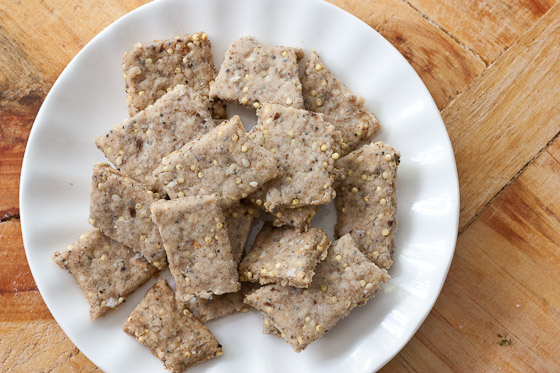
Choose Your Shape: Little Free-Form Square Crackers
Wheat Crackers
From: The Homemade Pantry: 101 Foods You Can Stop Buying and Start Making
Makes: 50-60 small crackers or 20 large crackers
1 cup (5 ounces) all-purpose flour, plus additional for the counter
1 cup (4.75 ounces) spelt flour or whole wheat flour (4.5 ounces)
1/2 teaspoon baking powder
1/3 cup whole, uncooked millet
1/3 cup ground flax seeds
1/2 teaspoon kosher salt, plus additional for sprinkling
Optional: 5 medium garlic cloves, minced, and 1 tablespoon fresh rosemary
1/2 cup plus 2 tablespoons olive oil
Freshly ground pepper
1. Preheat the oven to 350 F. In a medium bowl, combine the two flours, baking powder, millet, flax, salt, and garlic and rosemary, if using. Add the olive oil and combine with a fork. Slowly add 1/2 cup water, mixing with your hands as you go. Continue to add more water (up to 1/4 cup additional water) to the dough until it holds together. Knead the dough with your hands in the bowl for 2 minutes until it is smooth and very workable.
2. Turn out the dough onto a floured surface, press into a flat disc, and roll with a rolling pin until the dough is 1/8 to 1/4 inch thick. For square crackers, use a pizza wheel or sharp knife and cut the dough into 2-inch squares. For round crackers, use a 2-inch biscuit cutter. Any leftover dough can be rerolled for more crackers.
3. With a spatula, transfer the cut dough to ungreased cooking sheets and sprinkle each cracker with salt and pepper. Bake for 20-22 minutes, switching the position of the sheets and rotating them midway through, until the crackers are hard to the touch. Transfer to a wire rack.
Storage: Room temperature, covered, 7 days; Freezer: Freezer-safe container or bag, 3 months.
Recipe reprinted with permission from Random House, Inc.
